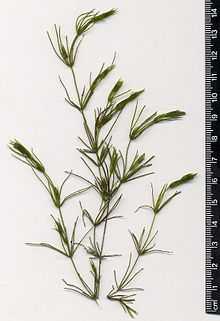Chara (alga)
| Chara Temporal range: Silurian–Recent[1] | |
|---|---|
 | |
| Chara globularis | |
| Scientific classification | |
| Kingdom: | Plantae |
| Division: | Charophyta |
| Class: | Charophyceae |
| Order: | Charales |
| Family: | Characeae |
| Genus: | Chara L., 1753 |
| Species | |
|
See text | |
Chara is a genus of green algae in the family Characeae. They are multicellular and superficially resemble land plants because of stem-like and leaf-like structures. They are found in fresh water, particularly in limestone areas throughout the northern temperate zone, where they grow submerged, attached to the muddy bottom. They prefer less oxygenated and hard water and are not found in waters where mosquito larvae are present.[citation needed] They are covered with calcium carbonate deposits.
Structure
The branching system of Chara species is complex with branches derived from apical cells which cut off segments at the base to form nodal and internodal cells alternately. They are typically anchored to the littoral substrate by means of branching underground rhizoids. Chara plants are rough to the touch because of deposited calcium salts on the cell wall. The metabolic processes associated with this deposition often give Chara plants a distinctive and unpleasant smell of hydrogen sulfide.[2]
Morphology
The plant body is a gametophyte. It consists of a main axis (differentiated into nodes and internodes), dimorphic branches (long branch of unlimited growth and short branches of limited growth), rhizoids (multicellular with oblique septa) and stipulodes (needle shaped structures at the base of secondary laterals.
Reproduction

Chara reproduces vegetatively and sexually. Vegetative reproduction takes place by tubers, amylum stars and secondary protonema. The fructifications for sexual reproduction are globule or antheridium (male) and nucule or archegonium (female).
Species
- Chara braunii (ITIS)
- Chara canescens (ITIS)
- Chara contraria (ITIS) opposite stonewort
- Chara corallina (ITIS)
- Chara elegans (ITIS)
- Chara excelsa (ITIS)
- Chara fibrosa (ITIS)
- Chara formosa (ITIS)
- Chara fragilis (ITIS)
- Chara globularis (ITIS)
- Chara hispida (ITIS)
- Chara hornemannii (ITIS)
- Chara intermedia (ITIS)
- Chara nataklys
- Chara sejuncta (ITIS)
- Chara virgata (ITIS)
- Chara vulgaris (ITIS)
- Chara zeylanica (ITIS)
- Chara connivens (convergent stonewort)
Distribution
Northern Hemisphere
There are about 40 species of Chara in Europe. They are commonly found in the specific habitat-type designated as H3140 (hard oligo-mesotrophic waters with benthic vegetation of Chara spp h1) in the Natura 2000 plans of the European Union. Although this habitat is found all across Europe, it is threatened and to be protected and preserved.
The Netherlands are home to 20 species Chara, growing in lakes and ponds of the habitat-type H3140. The H3140 habitats in the Netherlands, are considered important in the overall preservation efforts and therefore also for the Chara species in general.[3]
Denmark. Here many former Chara habitats (H3140), have been polluted by either toxins or excessive amounts of nutrients (in particular phosphates and nitrogen), but a few large lakes and ponds remain. Chara is found growing in the very clean hard water lakes of Thy National Park like Nors Sø for example. Tissø lake (fourth largest lake in Denmark) is also a H3140 habitat and contains Chara species.[4][5]
Ireland:- Co. Galway. Eglinton Canal Chara virgata Kütz., Chara rudis (A.Braun) Leonhardii and Nitella flexilis (L.) C.Agardh.[6]
Southern Hemisphere
Chara is found from 69 degrees north in northern Norway to about 49 degrees south in Kerguelen Islands (Pal et al., 1962).
References
- ↑ Palmer, Douglas; et al. (2009), Prehistoric Life: The Definitive Visual History of Life on Earth (first American ed.), Dorling Kindersley, p. 419, ISBN 978-0-7566-5573-0
- ↑ F.E.Round. 1966. The Biology of the algae. Ernest Arnold.
- ↑ H3140 - Hard oligo-mesotrophic waters with benthic vegetation of Chara spp h1.
- ↑ 3140 Hard oligo-mesotrophic waters with benthic vegetation of Chara spp h1. Danish Nature agency (Danish)
- ↑ Natura 2000 basic analysis 2015-2021 for Hanstholm Reservatet, Hanstholm Knuden, Nors Sø and Vandet Sø Danish Nature Agency 2013 (Danish) ISBN 978-87-7091-034-7
- ↑ Pybus, C. and O'Halloran, P. 2009. Distribution of some submerged aquatic macrophytes in Eglinton Canal, Galway. Ir. Nat. J. 30: 51 - 53